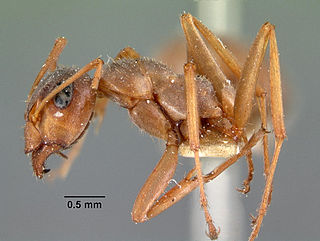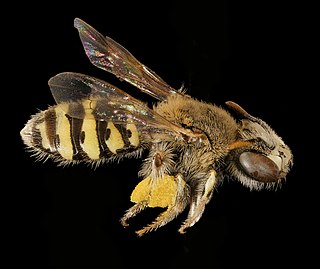Related Research Articles
Centris cockerelli is a species in the family Apidae, in the order Hymenoptera . The distribution range of Centris cockerelli includes Central America and North America.

Hoplitis anthocopoides is a species in the family Megachilidae, in the order Hymenoptera . The distribution range of Hoplitis anthocopoides includes Africa, Europe & Northern Asia, and North America.

Formica montana is an ant in the genus Formica in the family Formicidae. A common name for F. montana is "prairie mound ant".

The hawthorn miner bee is a species of miner bee in the family Andrenidae which is in the order Hymenoptera. Another common name for this species is hawthorn andrena. It is found in North America.
Colletes simulans is a species in the family Colletidae, in the order Hymenoptera. The species is known generally as the "spine-shouldered cellophane bee". It is found in North America.
Crabro villosus is a species in the order Hymenoptera, in the class Insecta ("insects"). It is found in North America.

Andrena krigiana is a species in the family Andrenidae, in the order Hymenoptera. The species is known generally as the "dwarf-dandelion andrena". It is found in North America.
Stictiella formosa is a species in the order Hymenoptera, in the class Insecta ("insects"). The distribution range of Stictiella formosa includes Central America and North America.

Formica fossaceps is a species of ant in the genus Formica, in the family Formicidae. This species is a member of the Formica rufa species group.

Eremnophila aureonotata is a species in the family Sphecidae, in the order Hymenoptera.
Osmia glauca is a species in the genus Osmia, in the family Megachilidae . It is found in North America.
Andrena palpalis is a species of mining bees in the family Andrenidae. It is found in Central America and North America.
Triepeolus grandis is a species of cuckoo bees in the family Apidae. It is found in Central America and North America.

Triepeolus is a genus of cuckoo bees in the family Apidae. There are at least 140 described species in Triepeolus.

Townsendiellini is a tribe of bees in the family Apidae. There are at least 3 described species in Townsendiellini.

Calliopsini is a tribe of mining bees in the family Andrenidae. There are at least 120 described species in Calliopsini.
Neopasites is a genus of cuckoo bees in the family Apidae. There are about 5 described species in Neopasites.
Triepeolus rufithorax is a species of cuckoo bee in the family Apidae. It is found in North America.

Dufourea monardae, the monarda dufourea, is a species of sweat bee in the family Halictidae. It is found in North America. It is an oligolectic bee on bee balm plants.

Dufourea is a genus of sweat bees in the family Halictidae. There are at least 160 described species in Dufourea.
References
- ↑ "Nomada verecunda species information". bugguide.net. Retrieved 15 January 2018.
- 1 2 "Integrated Taxonomic Information System (ITIS)". itis.gov. Retrieved 15 January 2018.
- ↑ "Encyclopedia of Life Nomada verecunda species overview". eol.org. Retrieved 15 January 2018.
- ↑ Phylogeny and classification of Hymenoptera, Sharkey M.J. 2007.
- ↑ Phylogenetic relationships among superfamilies of Hymenoptera, Sharkey M.J., Carpenter J.M., Vilhelmsen L., et al. 2012. Cladistics 28(1): 80-112.